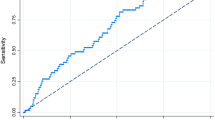Abstract
Advances in the field of risk assessment have highlighted the importance of developing and validating models for problematic or unique subgroups of individuals. Stalking offenders represent one such subgroup, where fears of and potential for violence are well-known and have important implications for safety management. The present study applies a Classification and Regression Tree (CART) approach to a sample of stalking offenders in order to help further the process of identifying and understanding risk assessment strategies. Data from 204 stalking offenders referred for psychiatric evaluation to a publicly-funded clinic were used to develop and assess putative risk factors. A series of nested models were used to generate tree algorithms predicting violence in this sample of offenders. Both simplified and more extensive models generated high levels of predictive accuracy that were roughly comparable to logistic regression models but much more straightforward to apply in clinical practice. Jack-knifed cross-validation analyses demonstrated considerable shrinkage in the CART, although the models were still comparable to many other actuarial risk assessment instruments. Logistic regression models were much more resilient to cross-validation, with relatively modest loss in predictive power.
Similar content being viewed by others
References
Banks, S., Robbins, P. C., Silver, E., Vesselinov, R., Steadman, H. J., Monahan, J., et al. (2004). A multiple-models approach to violence risk assessment among people with mental disorder. Criminal Justice and Behavior, 31, 324–340.
Barabee, H. E., Seto, M. C., Langton, C. M., & Peacock, E. J. (2001). Evaluating the predictive accuracy of six risk assessment instruments for adult sex offenders. Criminal Justice and Behavior, 28, 490–521.
Barnes, G. M., Welte, J. W., & Dintcheff, B. (1991). Drinking among subgroups in the adult population of New York State: A classification analysis using CART. Journal of Studies on Alcohol, 52, 338–344.
Belle, S. H., Mendelsohn, A. B., Seaberg, E. C., & Ratcliff, G. (2000). A brief cognitive screening battery for dementia in the community. Neuroepidemiology, 19, 43–50.
Boerstler, H., & de Figueiredo, J. M. (1991). Prediction of use of psychiatric services: Application of the CART algorithm. Journal of Mental Health Administration, 18, 27–34.
Brieman, L., Friedman, J. H., Olshen, R. A., & Stone, C. J. (1984). Classification and regression trees. Boca Raton, FL: Chapman & Hall/CRC.
Doering, S., Mueller, E., Keopcke, W., Pietzcker, A., Gaebel, W., Linden, M., et al. (1998). Predictors of relapse and rehospitalization in schizophrenia and schizoaffective disorder. Schizophrenia Bulletin, 24, 87–98.
Gardner, W., Lidz, C. W., Mulvey, E. P., & Shaw, E. C. (1996). A comparison of actuarial methods for identifying repetitively violent patients with mental illnesses. Law and Human Behavior, 20, 35–48.
Hanson, R. K., & Thornton, D. (2000). Improving risk assessments for sex offenders: A comparison of three actuarial scales. Law and Human Behavior, 24, 119–236.
Kropp, P. R., Hart, S. D., & Lyon, D. R. (2002). Risk assessment of stalkers: Some problems and possible solutions. Criminal Justice and Behavior, 29, 590–616.
Lemsky, C. M., Smith, G., Malec, J. F., & Ivnik, R. J. (1996). Identifying risk for functional impairment using cognitive measures: An application of CART modeling. Neuropsychology, 10, 368–375.
Litwack, T. R. (2001). Actuarial versus clinical assessments of dangerousness. Psychology, Public Policy, and Law, 7, 409–443.
Monahan, J., Steadman, H. J., Appelbaum, P. S., Robbins, P. C., Mulvey, E. P., Silver, E., et al. (2000). Developing a clinically useful actuarial tool for assessing violence risk. British Journal of Psychiatry, 174, 312–319.
O’Connor, M., & Rosenfeld, B. (2004). Introduction to the special issue on Stalking: Finding and filling the empirical gaps. Criminal Justice and Behavior, 31, 3–8.
Quinsey, V. L., Harris, G. T., Rice, M. E., & Cormier, C. A. (1998). Violent offenders: Appraising and managing risk. American Psychological Association Press: Washington, DC.
Rosenfeld, B. (2004). When stalking turns violent: Developments in the assessment of stalking risks. In M. Brewster (Ed.). Stalking Victims and Offenders: Treatment, Intervention and research. Kingston, NJ: Civic Research Institute (pp. 98–114).
Rosenfeld, B., & Harmon, R. (2002). Factors associated with violence in stalking and obsessional harassment cases. Criminal Justice and Behavior, 29, 671–691.
Silver, E., & Chow-Martin, L. (2002). A multiple-models approach to assessing recidivism risk: Implications for judicial decision making. Criminal Justice and Behavior, 29, 538–568.
Stalens, L. J., Yarnold, P. R., Seng, M., Olson, D. E., & Repp, M. (2004). Identifying three types of violent offenders and predictinv violent recidivism while on probation: A classification tree analysis. Law and Human Behavior, 28, 253–271.
Steadman, H. J., Mulvey, E. P., Monahan, J., Robbins, P. C., Appelbaum, P. S., Grisso, T., et al. (1998). Violence by people discharged from acute psychiatric inpatient facilities and by others in the same neighborhoods. Archives of General Psychiatry, 55, 393–401.
Steadman, H. J., Silver, E., Monahan, J., Appelbaum, P. S., Robbins, P. C., Mulvey, E. P., et al. (2000). A classification tree approach to the development of actuarial violence risk assessment tools. Law and Human Behavior, 24, 83–100.
Webster, C. D., Hucker, S. J., & Bloom, H. (2002). Transcending the actuarial versus clinical polemic in assessing risk for violence. Criminal Justice and Behavior, 29, 659–665.
Author information
Authors and Affiliations
Corresponding author
About this article
Cite this article
Rosenfeld, B., Lewis, C. Assessing Violence Risk in Stalking Cases: A Regression Tree Approach. Law Hum Behav 29, 343–357 (2005). https://doi.org/10.1007/s10979-005-3318-6
Issue Date:
DOI: https://doi.org/10.1007/s10979-005-3318-6




